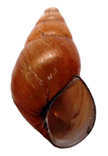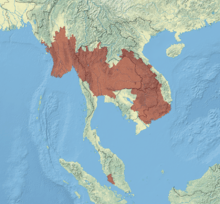Bithynia siamensis
Bithynia siamensis is a species of a freshwater snail with a gill and an operculum, an aquatic prosobranch gastropod mollusk in the family Bithyniidae.

Apertural view of the shell of Bithynia siamensis goniomphalus
| Bithynia siamensis | |
|---|---|
 | |
| Apertural view of the shell of Bithynia siamensis siamensis | |
| Scientific classification | |
| Kingdom: | Animalia |
| Phylum: | Mollusca |
| Class: | Gastropoda |
| Clade: | Caenogastropoda |
| Clade: | Hypsogastropoda |
| Order: | Littorinimorpha |
| Superfamily: | Rissooidea |
| Family: | Bithyniidae |
| Genus: | Bithynia |
| Species: | B. siamensis |
| Binomial name | |
| Bithynia siamensis Lea, 1856 | |
Subspecies
WHO (1995)[2] recognized the following subspecies:
- Bithynia siamensis siamensis - synonym: Bithynia siamensis goniomphalus[2]
- Bithynia siamensis funiculata[2]
- Bithynia siamensis laevis[2]
Bithynia siamensis and Bithynia funiculata (synonym: Bithynia goniomphala) were recognized as separate species in the 2012 IUCN Red List.[1][3]

Distribution map of Bithynia siamensis.
Distribution
This species occurs in:
The population of Bithynia siamensis fluctuates during the year.[4]
Parasites
Bithynia siamensis serves as a first intermediate host for Southeast Asian liver fluke Opisthorchis viverrini.[2] The number of excretory cells of the digestive system is increased in infected Bithynia siamensis.[5]
Parasites of Bithynia siamensis include trematode Multicotyle purvisi.[6]
gollark: I don't know.
gollark: This is interesting, my logs show actual visitor-like behavior from an IP address geolocating to Indonesia.
gollark: That is your problem.
gollark: ```<> 178.238.238.221 [07/Jun/2020:08:35:22 +0000] "GET / HTTP/1.0" 301 169 "-" "masscan/1.0 (https://github.com/robertdavidgraham/masscan)"```
gollark: The logs are *interesting*.
References
- Richter K. & Simonis J. (2012). "Bithynia siamensis". In: IUCN 2012. IUCN Red List of Threatened Species. Version 2012.2. <www.iucnredlist.org>. Downloaded on 31 December 2012.
- World Health Organization (1995). "Control of Foodborne Trematode Infection". WHO Technical Report Series (849): 126.. PDF part 1, PDF part 2
- Richter K. & Simonis J. (2012). "Bithynia funiculata". In: IUCN 2012. IUCN Red List of Threatened Species. Version 2012.2. <www.iucnredlist.org>. Downloaded on 30 December 2012.
- Upatham, E. S.; Sukhapanth, N. (1980). "Field studies on the bionomics of Bithynia siamensis siamensis and the transmission of Opisthorchis viverrini in Bangna, Bangkok, Thailand". The Southeast Asian journal of tropical medicine and public health. 11 (3): 355–358. PMID 7444576..
- Adam, R.; Pipitgool, V.; Sithithaworn, P.; Hinz, E.; Storch, V. (1995). "Morphology and ultrastructure of the digestive gland of Bithynia siamensis goniomphalus (Prosobranchia: Bithyniidae) and alterations induced by infection with the liver fluke Opisthorchis viverrini (Trematoda: Digenea)". Parasitology research. 81 (8): 684–692. doi:10.1007/bf00931847. PMID 8570585.
- Alevs, Philippe V.; Vieira, Fabiano M.; Santos, Cláudia P.; Scholz, Tomáš; Luque, José L. (2015-02-12). "A Checklist of the Aspidogastrea (Platyhelminthes: Trematoda) of the World". Zootaxa. 3918 (3): 339–96. doi:10.11646/zootaxa.3918.3.2. ISSN 1175-5334. PMID 25781098.
- Phongsasakulchoti, P.; Sri-Aroon, P.; Kerdpuech, Y. (2005). "Emergence of Opisthorchis viverrini cercariae from naturally infected Bithynia (Digoniostoma) siamensis goniomphalos". The Southeast Asian journal of tropical medicine and public health. 36 Suppl 4: 189–191. PMID 16438207..
Further reading
- Chitramvong, Y. P. (1992). "The Bithyniidae (Gastropoda: Prosobranchia) of Thailand: comparative external morphology". Malacological Review. 25: 21–38.
This article is issued from Wikipedia. The text is licensed under Creative Commons - Attribution - Sharealike. Additional terms may apply for the media files.
